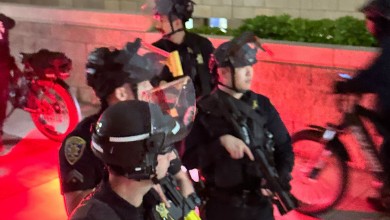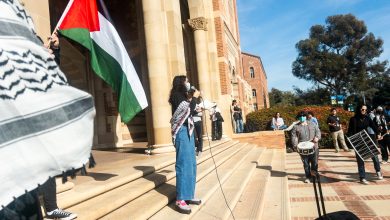Why History Matters: Women’s Rights as Human Rights
By Vivian Giang and Dana Yu
On March 4, 2014, UCLA’s History Department hosted their quarterly “Why History Matters” panel discussion. This quarter, it focused on the topic of “Women’s Rights as Human Rights” and was co-sponsored by UCLA’s law school. The three featured panelists were Asli Ü. Bâli, Assistant Professor at the UCLA School of Law, Charlotte Bunch, an activist and professor at Rutgers University, and Liesl Gerntholtz, the executive director of the Women’s Rights Division of Human Rights Watch, with UCLA Professor of History and Gender Studies Ellen Dubois as moderator.
The event began a little after 7 PM, with introductions from David Myers, the Chair of the UCLA Department of History, and Rachel Moran, a professor at the UCLA School of Law.
The main focus of the discussion was the resolution of the gap between human rights and women’s rights. Professor Dubois began by describing a short history of the concept of women’s rights as human rights, beginning in the post-World War II era up until present day.
HISTORICAL TO PRESENT DAY ISSUES
With the formation of the United Nations, there was some dissonance in how women’s rights should be viewed within the larger scope of human rights. While one faction thought that women’s rights should be thought of a sub-topic beneath human rights, another thought the conceptual positioning would make it easier for women’s rights to be ignored, shifted to the bottom of the pile. The latter faction won out, and the UN’s Commission on the Status of Women (CSW) was created in response.
This, however, was not enough to close the gap between women’s rights and human rights.
The panelists began the discussion by talking about the Universal Declaration of Human Rights, which was adopted by the UN in 1948, and how it was limited in terms of protecting women’s rights.
Asli Bâli explained that while the UDHR did not have a gendered title and referenced the equality of men and women, the Declaration was extremely broad and abstract and was then complicated by Cold War politics. She also explained the emphasis on civil and political rights, especially towards the Soviet Union, placed women at a disadvantage because women’s rights violations were not just legal norms, but cultural norms.
Describing how many legal norms often captured cultural norms and reinforced gender inequality, Bâli noted:
“The vast majority of breaches of women’s rights did not take place in the form of the iconic Soviet dissident, not that there weren’t dissident women, there were many, but the vast majority of women in the international system faced direct rights violation in the privacy of their own home.”
Because of this separation of the public and private sectors, it took more than just state efforts to intervene.
Charlotte Bunch spoke next about the history of women’s rights as human rights from an activist’s perspective. She started by saying that during the 1960s and 1970s, a new generation of female lawyers emerged that helped make women’s rights become considered as human rights.
It was at the 1985 World Conference for Women in Nairobi where the first discussions over whether international matters of development, war and peace, and equality should also include women occurred, and this new generation of feminist lawyers began to consider all of these international issues through a feminist lens. What seemed to incense them was that women who had suffered from international human rights’ violations–sex-trafficking, torture, etc.–were not being given political asylum simply because most of their abuses had occurred in the private sphere.
This period was when women first realized that the merging of women’s rights and human rights was a global effort; it was “not a movement that happened in isolation,” explained Bunch.
Liesl Gerntholz then discussed the current situation and groups that continually assist the in the minimizing difference between women’s rights and human rights. The Women’s Right’s Division of Human Rights Watch, of which Gerntholz is a part, essentially does documentation and records human rights violations, focusing on acts that don’t happen in the public sphere.
During the first decade of its creation, the Women’s Right Division worked on reporting domestic violence where non-state actors in the private sphere were participants and holding them responsible for their actions. During the second decade, this group focused on reproductive rights––namely, abortion and contraception.
Today, the group’s challenges include its descriptor as a “New York based lobby group,” as well as its position in the middle of class, race and gender lines.
VIOLENCE AGAINST WOMEN AS A HUMAN RIGHTS ISSUE
Next, Professor Dubois addressed the panel as a whole, asking “Why do you think framing violence against women as a human rights abuse rather than a women’s rights issue has been so fundamental?”
Bâli spoke first, explaining that by considering women’s rights as human rights, people have been able to bring up and consider the question of “What do we do about structural discrimination?” The 1993 World Conference on Human Rights in Vienna was an iconic moment where violence in the private sphere was a form of rights violation.
She also mentioned that the UN’s Committee on the Elimination of Discrimination against Women created General Recommendation #19, which stated that gender discrimination includes gender-based violence, and had an impact on making sure that women’s rights were considered human rights..
Bunch’s answer followed, saying that,
“Violence against women is the mechanism by which discrimination against women is maintained.”
She mentioned that she and other activists had the choice to focus on violence against women or illiteracy amongst women, and chose violence because women, regardless of their location, have constantly dealt with the issue of violence. Therefore, she explained, it was an issue that all women could feel like they had a stake in, and ensure that the international community would take responsibility.
Gerntholz began with a focus on the Yugoslav Wars and the advent of 24-hour news services, which made violence against women more transparent. Both events also allowed Human Rights Watch to conduct real-time reporting on human rights violations. She then spoke about how violence against women is “close to home.”
In the United States, specifically California, rape kits are held en masse in warehouses, where they are never tested. Rape kits are manila folders that hold evidence of rape, collected through an often traumatic examination that takes place almost immediately after sexual assault. Human Rights Watch is, she said, working to ensure that rape kits will not be warehoused and forgotten, especially when they could help prevent rapists from sexually assaulting more people.
AUDIENCE QUESTIONS
After the discussion, the panelists answered questions from the audience and elaborated on points they thought were most pertinent.
One of the points discussed was the concentration and emphasis put on girls rather than women as a whole. For Bunch, the perspective that education for girls would be a “life raft” for the improvement of society is fundamentally flawed for two reasons: The first is that education for girls seems to extend only to primary schooling, and the second is that with the focus on girls, there’s less of an incentive to focus on women as a whole beyond childhood.
It’s not just about getting girls into school, it’s about keeping them there, and then after that, it’s about allowing them basic human rights because, as demonstrated by the panelists, women rights are human rights and vice versa.
Another question asked about the use of isolating men from activism against human rights violations, when men experience sexual assault and other issues that are typically considered “female” experiences. Bunch answered by stating that none of the issues men and boys experience, including rape, would have been brought to light had it not been for women.
It is not about separating human’s rights into women’s rights and men’s rights, she continued, but rather how to get these issues to be seen, discussed and fixed.
The last point of elaboration–however little–was that of women of color and their place in women’s rights feminism. Due to the time constraint, the panelists could not answer this; however, they acknowledged that it was an issue that needed to be addressed and suggested it would have been addressed had the time not run out.




